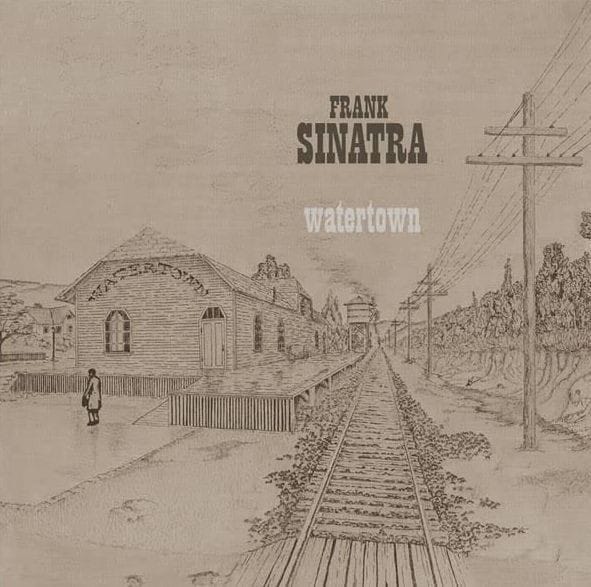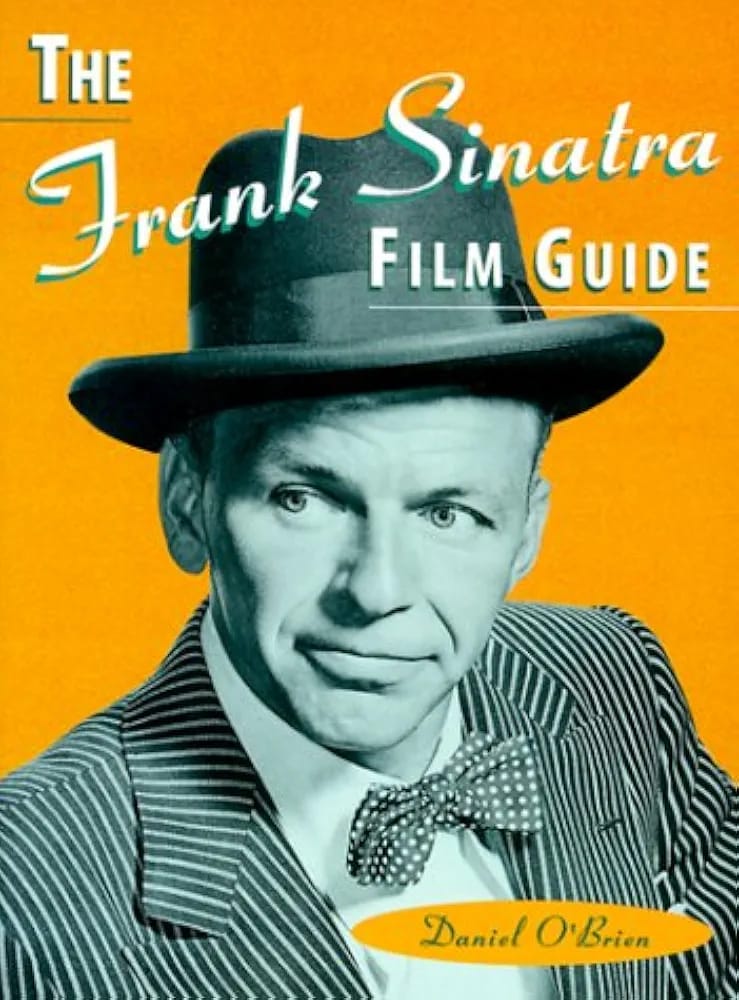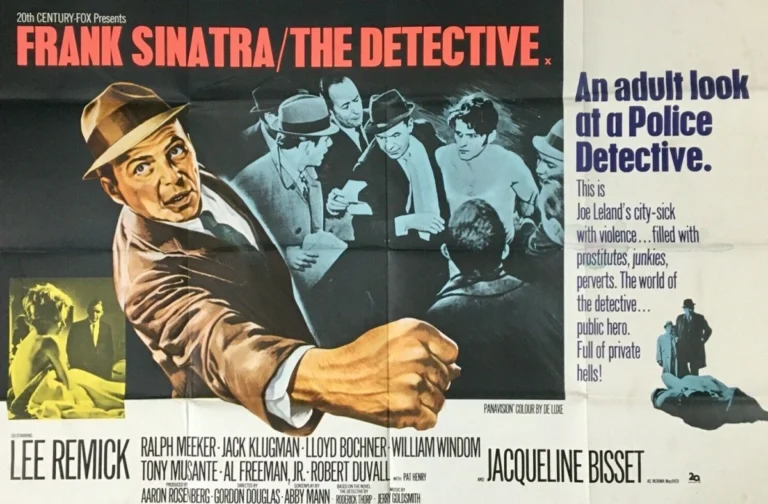
“WATERTOWN”
Analysis and criticism of the original album.
FRANK SINATRA DISCOGRAPHY WATERTOWN. For more than half a century, “Watertown,” Frank Sinatra’s most controversial and ambitious album, has gathered much silent dust on itself. This dark conceptual work with folk rock touches was ignored at the time by Sinatra’s classic followers, accustomed to the delights that Hoboken’s voice was capable of creating with the select ingredients of the Great American Songbook.
The young and idealistic public that fought for the revolution on the backs of horses without helmets also had no interest in the disenchanted message of a man whom they considered part of the oppressive system. Even authors most versed in the art of writing about Sinatra have treated the album with various levels of disdain. But what surprises time has in store as it relentlessly strips away both the material and the immaterial! “Watertown” has become a cult LP, applauded by musicians, critics and fans who have been able or wanted to listen to it with new ears, there are even those who have praised it as their favorite within the legacy of The Voice. For years there was a website dedicated exclusively to him, and in 2022 tribute will be paid to him in an unusual reissue with the remixed sound, an honor that other, much more popular albums in his discography have not enjoyed.
Many music media have echoed the relaunch, in most cases reproducing, without further additions, the official press release from the record company. In this guide I will talk about the general aspects of the album.
ARGUMENT
The work tells the first-person story of a working-class man who lives with his two children in Watertown, a gray, nondescript town in which nothing extraordinary ever happens. They were abandoned by Elizabeth, the wife and mother, who went to the big city pursuing the dream of becoming an artist. The songs take us on a journey through the emotions of the protagonist, his desolation and hope, sometimes in the form of letters addressed to Elizabeth.
Finally, after a long period of time, the woman writes announcing her return to Watertown. The protagonist goes to meet her at the train station but the meeting does not take place, at least before us. The song “Lady Day”, which was not conceived as part of the album and was added in the 1994 compact disc reissue, offers us an ending in which Elizabeth died before being able to return, but the truth is that the song, according to told lyricist Bob Gaudio in 2022, it was a tribute to Billie Holiday that Sinatra couldn’t resist recording.
Jake Holmes, one of the album’s lyricists, recalled that the story of “Watertown” arose from the song “Goodbye (She Quietly Says),” inspired by the type of goodbyes people have in which emotionally nothing happens.
Frank’s character was basically a good guy, the kind of guy who really lived in Watertown. His entire orientation was family and work;
Elizabeth was more restless, a more contemporary woman. I wanted to do other things. She wasn’t liberated enough to tell him, and she didn’t think he understood. He abandoned his family and went to look for a career, and perhaps for some other reason, as we will see later, when analyzing the repertoire.
HISTORICAL CONTEXT
The Vietnam War was a great failure for the United States. His participation in it opened a great wound in North American society itself and created deep unrest within it, aggravated by the struggle for civil rights and youth opposition to the system.
The American dream, along with the ideal of peace and love that had flourished in the 1960s, seemed to fade in the face of evidence of inequalities and widespread protest. The hippy mirage that reached its peak at the Woodstock festival was shattered in the blood of Cielo Drive and Altamont and buried without honor during the chaotic third edition of the Isle of Wight festival in 1970.
Frank Sinatra, like much of his generation, witnessed with amazement the rapid disappearance of that world that was once his. In the new social and cultural scenario, he showed signs of an erratic and anxious struggle to maintain validity, having to face several personal problems. He began 1969 suffering, on January 24, the loss of his father due to a heart attack. The event was devastating for him, and his only refuge seemed to be work, to which he devoted himself with particular intensity.
Between February 11 and 24, he recorded enough songs to make the LP “My Way” and a second album with Antonio Carlos Jobim that was finally reduced to side A of “Sinatra & Company” in 1971.
Between March 19 and 21 he recorded “A Man Alone”, the first album of his career made up of songs by a single author, the poet Rod McKuen. This introspective and philosophical ode to loneliness provides a pristine panoramic view of the interior landscape of the Sinatra of that time, an unredeemed solitary in the midst of the perennial crowd that surrounded him, but also a man afraid of being left alone with his thoughts when silence falls.
The unusual and bitter romanticism that permeates the album did not play in favor of its commercial prosperity, but we were left with a chilling and beautiful document, with as much truth as any of their most glorified albums.
Afterwards, he spent almost the entire month of May offering concerts at Caesar’s Palace in Las Vegas, and in August.
Before recording his voice for “Watertown,” he received, along with several showbiz stars, the Apollo XI astronauts at the Houston Astrodome.
The origin of “Watertown” lies in the friendship between Sinatra and Frankie Valli – the singer of The Four Seasons – who met in the mid-1960s at the restaurant of Jilly Rizzo, a close friend of The Voice.
During dinner, a cordial relationship was forged between the two; Sinatra asked about the great commercial success of The Four Seasons’ music, and Valli explained that the secret was with Bob Gaudio, the group’s backing vocalist and pianist, who wrote and produced most of the material. Frank immediately showed interest in having Gaudio write some songs for him. According to Gaudio himself, he and Sinatra met in Las Vegas in mid-1968 and talked about working together. The nature of the project has not yet been finalized, but both were clear that they wanted to do something that would be challenging.
As the 1960s drew to a close, popular music became more sophisticated in its discourse and the way it reached its audience. The conceptual album gained importance as a vehicle for a story whose beginning, middle and end take place in the confines of the microgroove.
Bob Gaudio and Jake Holmes began by writing four songs that caught Frank’s attention, and the matter evolved naturally into the creation of a concept album – and initially a television special – set in a stereotypical small town in middle-class America, a stage far from the themes and atmospheres characteristic of Sinatra’s music; However, for the singer the idea was fantastic, and it represented a coherent step, an update of the heartbreak-themed albums that he had recorded in the previous decade with Capitol Records, for this occasion stripping them of romanticism and leaving only the bare bones. of the drama.
PRODUCTION, RECORDING AND RELEASE
Gaudio and Holmes had already written the songs for The Four Seasons’ concept album “The Genuine Imitation Life Gazette”, released in January 1969, which also marked a break with the band’s soft and friendly style. The turbulent times of the late 1960s did not give rise to the romantic songs with which the group had continually topped the charts between 1962 and 1964, and this work addressed topics such as the decline of the traditional family, war and racial tension. It is worth mentioning, as a curiosity, that in one of the songs on the album, “Mrs. Stately’s Garden” the name of a place called Watertown is mentioned.
“The Genuine Imitation Life Gazette” was a commercial failure, but that did not prevent the tandem of creators from enthusiastically starting their new conceptual work for Frank Sinatra. They both locked themselves up for almost two months in Gaudio’s house in California and worked around the clock to inspire inspiration.
The arrangements and musical direction were carried out by two men linked to The Four Seasons, Charles Calello and Joseph Scott, who were responsible for creating a captivating musical environment, which mixed classical patterns with contemporary ideas.
“Watertown” was recorded at Columbia Studios in New York. The orchestral tracks were recorded between July 14 and October 31, employing a method unusual for Sinatra, who sang over pre-recorded instrumentation; Apparently, this was done because his voice was not in the best moment in July and he also had not had time to know and assimilate the songs correctly. AFrank doesn’t like rushing when learning a song. He took his time to understand it, and appreciate the value of the song.
Sometimes it took him a week before he got it.
Jake Holmes was impressed by Frank’s respect for the work of lyricists and composers. He also highlighted the honesty of the singer, who did not sing to show how well he could sing. He always immersed himself in the song. He sang the words because they mattered to him. (…) What I respected most about Sinatra as a singer was his commitment to the song, even at the expense of his own voice.
The cover is a beautiful work by Ove Olsen in pen and ink. Shows the panorama of Watertown on a cold, rainy day. The streets are deserted, except for three figures in the vicinity of the train station; Our protagonist, dressed in a coat, has left the platform and walks regretfully towards his two sons, Michael and Peter, who are waiting for him a few meters ahead. On the horizon towards which the tracks run, you can see the smoke of the train that has taken Elizabeth. Now the children will have to go to school and their father will have to work, life goes on even though their world is falling apart. Inside the album folder is a collage with various elements that allude to the protagonist’s family life and help us better understand his story: watches, toys, cards, letters, glasses, scissors and a photo album , in which we see a dog, everyday scenes, some more romantic, an old car and, in a photo outside the album, the face of a woman who is surely Elizabeth. Also included was a poster of Sinatra, dressed casually in brown pants and a white sweater and jacket. He embodies his character on the album, waiting with a reflective and hopeful expression for the train that should bring Elizabeth back.
Frank, about to turn fifty-four, was far from settling into his numerous past successes. He had a sincere desire to find and offer new forms of communication. Bob Gaudio commented: “He was very confident and comfortable taking the risk, to the point of giving his approval to a cover without his face on it.”
But the album, presented in March 1970, had a poor impact on the market, staying at number 101 on the North American charts and remaining there for a period of only ten weeks, with sales of just 35,000 copies. In the United Kingdom the results were better, achieving a fourteenth place and nine weeks on the charts, improving the performance of “A Man Alone”.
Although Frank liked the album, he was dissatisfied with the state of his voice, found the recording process strange and frustrating, and had no desire to tackle the television show that was to complete the project. It was suggested that the release be postponed until perhaps he felt better about doing the TV show. However, he said he was proud of it and that they should take it out. And the album was released, but without receiving adequate promotional support from Reprise.
Frank also made no effort to include songs from the album in his concerts or in the “Sinatra” television special broadcast in November 1969.
The failure of this work was a blow to the singer and, perhaps, an accelerant in his decision to retire. He spent almost a year away from the recording studios, the longest period of silence in his career to date, and when he returned, it was to record a deliberately commercial selection of songs for the album “Sinatra & Company,” which, again, It had a disappointing reception from the public.
MY REVIEW
By tackling a project as disruptive as “Watertown” with a prestigious thirty-year career under his belt, Frank Sinatra demonstrated that he was the owner of a wide-angle mind and an irrepressible creative soul. Perhaps the first intention was to take advantage of Bob Gaudio’s talent to create irresistible commercial hits, but he was captivated by the set of songs that make up the story.
Frank got as involved as his energies and circumstances allowed him to, and both physical and mental fatigue and the discomfort of working so far from his stylistic precincts ended up playing to the benefit of the tense and depressing atmosphere, which characterizes the album, in a way. similar to the way in which the sentimental ordeal with Ava Gardner infiltrated the recording of her “saloon albums” to give them a bleeding beauty.
“Watertown” could well be a work by the Russian author Anton Chekhov, whose theatrical universe is inhabited by nostalgic and defenseless characters in the face of the reality they must face, and whose stories reveal more to us in what they omit than in what they tell. Gaudio and Holmes drew a hyperrealistic portrait of what happens countless times around the world behind the trappings of domestic life, with language without poetic flourishes. It is the subtext that tugs at our most sensitive chords; Each of the ten songs on “Watertown” allows us to imagine what happens before, during and after the scenes described, stories much more intense and dramatic than those that sound on the album.
It is a mistake to lyrically and musically compare “Watertown” to Sinatra’s classic albums, composed of songs from the Great American Songbook. It belongs to a different era, with its corresponding vision of the world. Nor is the Frank of 1969 the same as 1960 or 1956; Both the man and the artist have been transformed by the events inherent to a life that few of us can assimilate. In addition to several performances of great beauty and emotion (“Goodbye (She Quietly Says)”, “Michael And Peter”, “I Would Be In Love (Anyway)”, “Elizabeth”), the value of “Watertown” lies in its condition of almost palpitating witness of a moment of historical transition in the 20th century and also one of the most arduous stages in the future of the global being called Sinatra, when his human vulnerability was more present than ever in the art he gave to the world. Today, as at the time of its publication – perhaps even more so – the album acts as a soundtrack for an era of social and emotional isolation, collective disenchantment and individual fragility, particularly among generations that see their universe replaced by another more hostile and ungraspable
“Watertown” – 3:36
“Goodbye (She Quietly Says)” – 3:06
“For a While” – 3:09
“Michael & Peter” – 5:10
“I Would Be in Love (Anyway)” – 2:31
“Elizabeth” – 3:38
“What a Funny Girl (You Used to Be)” – 3:00
“What’s Now Is Now” – 4:04
“She Says” – 1:51
“The Train” – 3:26
“Lady Day” (Only on CD) – 2:47
By Mahnuel Muñoz https://www.facebook.com/mahnuelmunozoficial
Access the Complete Discography of Frank Sinatra in the following link of Sinatra Radio 24h https://sinatraradio24h.com/category/discography/
We remind you that you can also listen to Sinatra Radio 24 hours on your mobile phone by downloading our free applications for Android in the Play Store https://play.google.com/store/apps/details?id=sinatra.radio24h, and free applications for iOS in the Apple Store https://apps.apple.com/app/sinatra-radio-24h/id6599859344








